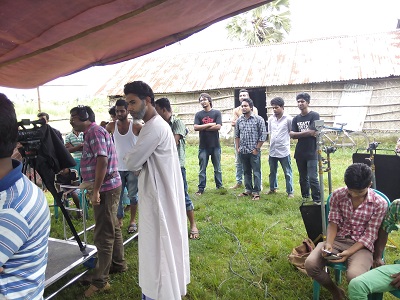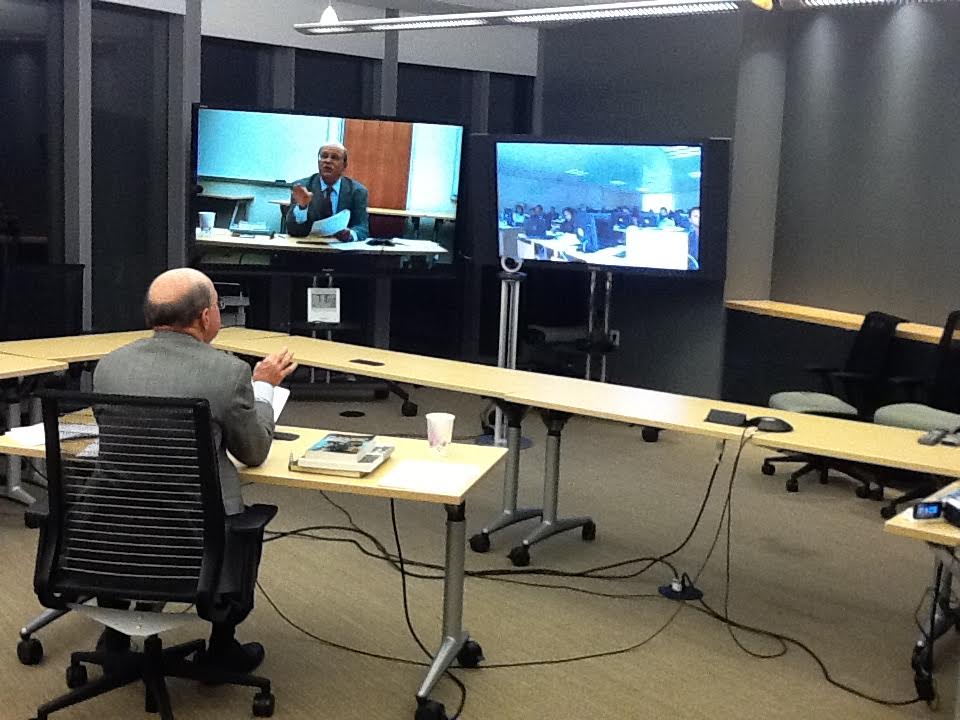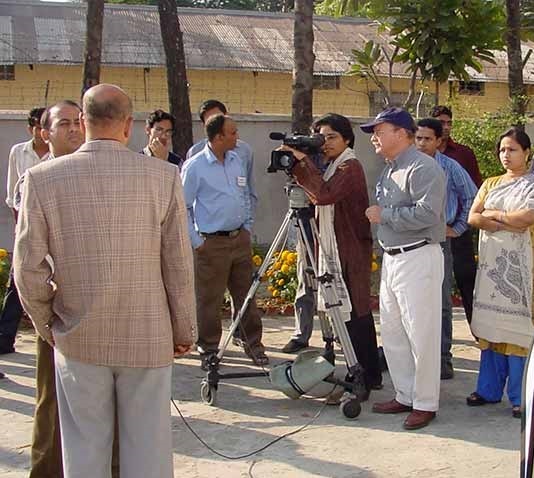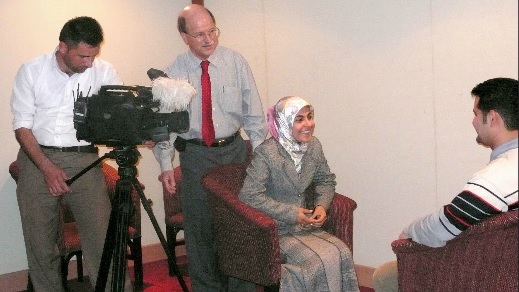Long-Distance Course Empowers Film Students to Tackle Ethnic, Religious and Sectarian Conflict
San Diego, February 5, 2016 — Every Wednesday evening for 15 weeks starting in April 2015, UC San Diego alumnus Robert Hooper (B.A. ’69) taught a class from a conference room in the Qualcomm Institute on the UC San Diego campus, just as he had done in 2014. But instead of teaching students in-person in San Diego, Hooper tutored and mentored students from five universities in Bangladesh over a two-way, interactive Internet videoconferencing link that piggybacked on the Qualcomm Institute’s advanced teleconferencing network.

The students were located in a classroom at the Independent University, Bangladesh (IUB) in Dhaka, the nation’s capital, more than 8,000 miles away (over 13,000 kilometers) from San Diego. In addition to students from IUB, participating students came from American International University-Bangladesh (AIUB), Chittagong University, Dhaka University, and Rajshahi University. (Dhaka University was represented in 2015 only: none of its students enrolled in the 2014 program.)
Now Hooper – a former lawyer, filmmaker and journalist who teaches at UC San Diego’s School of Global Policy and Strategy (GPS) – has published a retrospective on the long-distance course in an article for the January 2016 issue of the Georgetown Journal of International Affairs. In “How Film School Can Address Violent Extremism,” Hooper noted that in 2015, four bloggers and a publisher were attacked and killed by knife-wielding assailants in Dhaka. “More attacks are anticipated, causing growing alarm among those working in all forms of media and mass communication in Bangladesh,” said Hooper, adding that the “student films reveal not only the mundane origins of a typical young terrorist in Bangladesh, but also provide insights into the process of recruitment and radicalization.”

One of the student films, for example, was based on the 2013 murder of a Bangladeshi blogger whose Facebook posts criticized Islamic fundamentalism and extremist political parties. Another of the films portrayed an unprovoked attack on a female TV reporter by members of a militant Islamist organization in Bangladesh. “Their work helped reveal a frighteningly serious threat to Bangladeshi journalists and the local security services’ ineffectiveness in addressing the danger,” wrote Hooper in the Georgetown Journal. “In Bangladesh, anyone opposing a cleric’s extremist message in local press, on TV, or online is targeted as an ‘atheist’ subject to attack.”
“Effective counterterrorism must come from within the communities facing extremism,” Hooper argued. “Arming talented young students with the same persuasive weapons -- cameras, lights, microphones, laptops and counter-narratives – can help these communities win the war against violent extremism, where over a decade of ‘boots on the ground’ has failed.”
In earlier years, Hooper traveled to Bangladesh and other nations to deliver seminars and courses in-person, which allowed him to provide hands-on training (and to set up a network of former trainees who now serve as co-instructors at IUB). Thanks to the Qualcomm Institute’s routine use of videoconferencing that has linked Atkinson Hall to places as far afield as Tokyo, Amsterdam and São Paulo, Hooper was able to conduct the course from the UC San Diego campus streaming live to the university in Bangladesh. “Fortunately the director of the Qualcomm Institute, Professor Ramesh Rao, provided a space and technical support, which allowed us to enhance the equipment, film faculty and staff in Bangladesh to help teach and mentor the students to fulfill their course requirements.”

The two-year grant for “Filmmaking and TV Journalism for Peace and Tolerance in Bangladesh” kicked off in 2014 with 26 students, and a similar number completed the program in 2015. In both years, students teamed up to produce five documentaries or dramatic films.
Students learned the basics of journalism and how to produce original documentary and dramatic films to address issues of peace and tolerance, including efforts to understand the roots of violent extremism in Bangladesh. “Students were supervised in researching and writing final film scripts, planning their productions and shooting their films on locations in Dhaka and surrounding areas,” recalled Hooper. “They learned an enormous amount and key lessons in translating their ideas from written film scripts into effective and dramatically filmed scenes on location, often highly challenging.”
The AIUB film, “Bihari Camp”, tackled the history of impoverished Muslims from the Indian state of Bihar who emigrated to East Pakistan after Partition and long before the area gained its independence from Pakistan in 1971 as Bangladesh. The film recounts life in the present-day Bihari community, while also pointing to constructive improvements in that community since a 2008 law gave most Biharis full citizenship rights – ending decades as refugees. Another film, “The Guilt”, produced by students from Rajashahi University, dramatized the strikes and political unrest that rocked Bangladesh in February 2015, when activists began throwing petrol bombs at public transportation.

For the distance course, Hooper began webcasting his seminars and workshops at 7pm San Diego time to teach a morning course that began at 9am local time in Dhaka. Hooper and his co-instructors at IUB (including reporters, editors, producers and directors of photography) taught students how to write, shoot and edit their own documentary and dramatic films. “Professional TV production equipment and accessories were employed simultaneously in both the IUB and UC San Diego classrooms for a truly live, virtual experience,” explained Hooper.
The Bangladesh program did not end with graduation on July 31, 2015. Ten of the best students in Year 2 were selected to attend UC San Diego during the Fall 2015 quarter (through GPS’s Global Leadership Institute). The State Department grant similarly funded stays at UC San Diego for ten students in Fall 2014, bringing to 20 the total number of Bangladeshi students exposed to the San Diego campus under the two-year grant.
The long-distance course grew out of a project between 2003 and 2006, when Hooper spent time in Bangladesh teaching workshops and TV journalism courses in Dhaka and Chittagong. While training journalists as well as aspiring reporters and producers at the National Press Institute in 2005, Hooper’s visit coincided with a wave of terrorist bombings – convincing him to reframe the course as a way to introduce the role of journalism in fighting extremism. “We’ve achieved a groundbreaking new model to promote tolerance and counter extremism through filmmaking,” said Hooper.

“Only young, media-savvy artists, trusted by their peers, can help counter the domestic and transnational terrorists using social media to recruit vulnerable young people,” he wrote in the Georgetown Journal article. “Only these empowered youths can convince potential recruits that the call to violent extremism is unacceptable. As the student films illustrate, universities can play a significant role in cultivating a new generation of local filmmakers and social media activists. By providing them with the education, resources, and mentoring to oppose terrorism, the film community can empower student filmmakers to harness their own voices in promoting tolerance and bringing peace to their countries.”
Hooper has witnessed firsthand the role of media in conflict resolution, terrorism and human rights and has done extensive on-the-ground research. In 2008, he was deployed to train journalists and news crews in northern Iraq from the relative safety of the Kurdish city of Erbil (relative to Baghdad and most other cities in Iraq, where 130 journalists had died in the previous five years). Hooper has also trained journalists in Indonesia, Malaysia, Bangladesh, Laos, Papua New Guinea, Slovakia and Vanuatu, and served as a Fulbright Senior Scholar to Malaysia (1989), Indonesia (2001), and Fiji (1994). More recently, he served as the UC San Diego project director for “Promoting Independent and Free Media in Fiji,” with a two-year grant from the State Department’s Bureau of Democracy, Human Rights and Labor.
Related Links
How Film School Can Address Violent Extremism, Georgetown Journal of International Affairs
To Bangladesh and Back – February 2014 Article
Qualcomm Institute
Media Contacts
Doug Ramsey, 858-822-5825, dramsey@ucsd.edu
